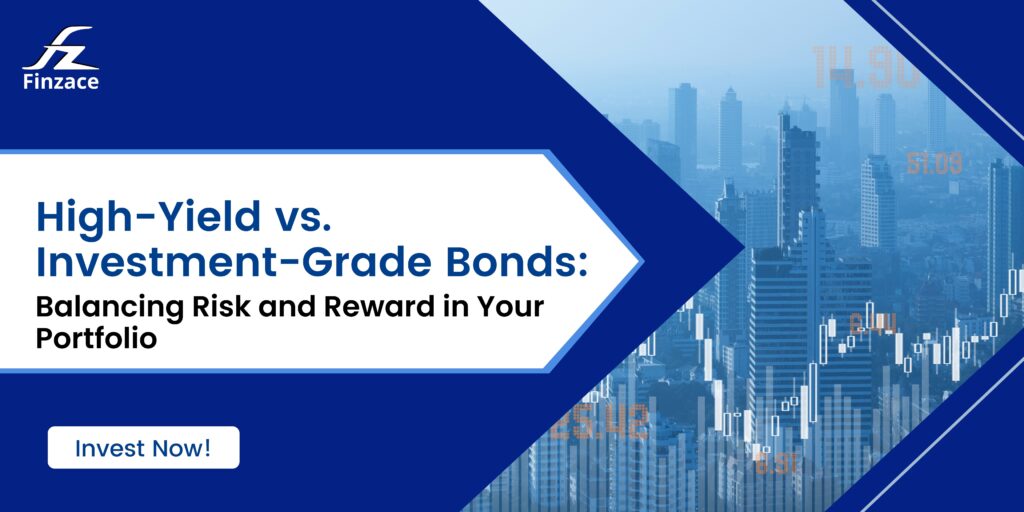High-Yield vs. Investment-Grade Bonds: Risk and Reward

Bonds provide a more stable investment experience in the fixed-income space than the volatile nature of stocks. But there is a range of risks and rewards even in the bond market. High-yield and investment-grade corporate bonds are primarily divided into two groups. Comprehending the distinctions between these two is essential to constructing a well-rounded and revenue-producing investment portfolio.
Investment-Grade Bonds: The Steady Eddie
Investment-grade bonds, often known as “high-quality” bonds, are issued by companies that have a solid track record of repaying their debts and sound financial standing. These bonds are assigned investment-grade ratings (BBB- or better by S&P/Fitch, Baa3 or higher by Moody’s) by reputable credit rating organizations such as Moody’s and Standard & Poor’s. Due to the issuer’s increased creditworthiness, there is a decreased chance that the principal or interest on the bond will not be repaid.
Advantages:
- Lower risk: The likelihood of an investment-grade issuer defaulting is significantly lower compared to high-yield issuers. This translates to peace of mind for investors seeking stability.
- Steady income: Investment-grade bonds typically offer consistent coupon payments, providing a reliable stream of income for your portfolio.
- Liquidity: These bonds are generally more actively traded in the secondary market, making it easier to buy or sell them before maturity if needed.
Disadvantages:
- Lower yields: Due to the lower perceived risk, investment-grade bonds generally offer lower interest rates compared to their high-yield counterparts.
- Interest rate sensitivity: When interest rates rise, the price of investment-grade bonds tends to fall. This is because investors can buy newer bonds with higher coupons.
High-Yield Bonds: Potentially Higher Returns, But a Bumpier Ride
“Junk bonds,” or high-yield bonds, are issued by corporations with lower credit ratings (Ba1 or worse from Moody’s, BB+ or lower from S&P/Fitch). These businesses can be in their infancy, experiencing financial difficulties, or participating in speculative markets. These bonds give investors far greater interest rates (coupons) than investment-grade bonds, which offsets the higher default risk attached to them.
Advantages:
- Higher potential returns: The allure of high-yield bonds lies in their potential for generating significantly more income than investment-grade bonds.
- Potential for price appreciation: If the issuer’s creditworthiness improves, the bond’s price may rise in the secondary market.
Disadvantages:
- Higher default risk: The biggest concern with high-yield bonds is the possibility of the issuer defaulting on its debt obligations. This could result in significant losses for investors.
- Greater volatility: High-yield bonds are generally more sensitive to market fluctuations, leading to greater price swings compared to investment-grade bonds.
- Lower liquidity: High-yield bonds may be less actively traded, making it more difficult to sell them quickly if needed.
Choosing Between High-Yield and Investment-Grade Bonds
The ideal choice between these two bond categories depends on your individual investment goals and risk tolerance. Here’s a quick breakdown to help you decide:
- Invest in high-yield bonds if: You have a longer investment horizon, can tolerate higher volatility, and prioritize maximizing your income potential.
- Invest in investment-grade bonds if: You prefer stability and capital preservation, have a shorter investment horizon, or are risk-averse.
Building a Balanced Portfolio
Adding both investment-grade and high-yield bonds to your portfolio is typically a wise strategy. This diversification offers a balance between capital preservation and income creation while reducing risk. When choosing the ideal weight for each category in your portfolio, take into account many aspects such as your age, risk tolerance, and overall asset allocation plan.
Recall that working with a financial advisor can help you design a customized investment strategy that meets your unique financial objectives.
Equity-Linked Savings Schemes (ELSS) offer a unique blend of tax-saving benefits and wealth-creation potential. With a lock-in period of just three years and the potential for higher returns compared to traditional tax-saving instruments, ELSS has emerged as a preferred choice for the best short-term fixed-income investments in India. However, it’s crucial to conduct thorough research, assess your risk profile, and align your investment goals before diving into ELSS. By leveraging the tax-saving benefits of ELSS and harnessing the power of equity investments, investors can unlock the doors to long-term wealth creation.
Finzace:
A diversified portfolio that meets your goals and provides the best short-term fixed-income investments.
Finzace’s secured investment options will give you the best fixed-return investment in India!
Just download the app and get the best short-term fixed-income investments for you. We provide you with investing choices that are backed by research and assets. Get low-risk investment options in India today like investment in NCDs and high-yield corporate bonds. Enjoy high-return fixed-income investments, the best safe investments with high returns, and secured investment options tailored to your needs.
Download our app now!!
Download link (Android): https://play.google.com/store/apps/details?id=icreditspace.com
Download link (Apple): https://apps.apple.com/in/app/finzace-earn-12-returns/id6446245952
